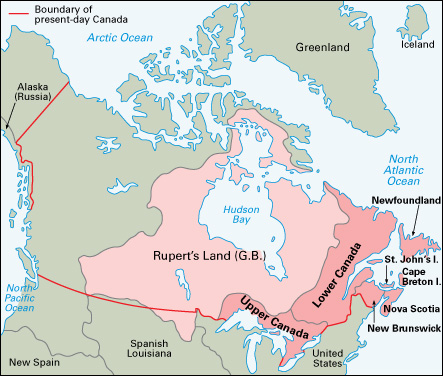Lower Canada was a British colony in North America. The British Parliament created Lower Canada in 1791. That year, the government divided its territory in what is now Ontario and Quebec into two colonies—Upper and Lower Canada. Lower Canada consisted of an area that is now southern Quebec. Upper Canada covered what is now southern Ontario.

In 1791, Lower Quebec had a population of about 160,000. A vast majority—about 150,000 people—were the descendants of French immigrants to Canada. They called themselves Canadiens. The population of Lower Canada also included about 10,000 British settlers. Some had moved from Europe or the American Colonies after the British took control of Canada from France during the Seven Years’ War (1756-1763). But most were British subjects who had left the American Colonies after the American Revolution (1775-1783). In general, the French settlers in Lower Canada were Roman Catholics, and the British settlers were Protestants.
Most Lower Canadians lived in rural areas and cultivated the land to survive. The colony’s economy depended upon the fur trade and the timber trade. Lower Canada’s Anglo-Protestant minority controlled both of these important commercial activities.
The British Parliament granted Lower Canada representative institutions of government in 1791. The colonial legislature consisted of a British governor, an appointed Legislative Council, and an elected Legislative Assembly. This system heightened the division between the British and French settlers. The commercially elite British controlled the Council. They wanted to promote international trade, immigration, and the growth of cities. The Canadiens dominated the Assembly. They wanted to help farmers and preserve the colony’s traditional rural society and French landholding system.
Lower Canada began to experience economic and political problems in the 1830’s. An increase in population made it difficult for new farmers to find land in the St. Lawrence River Valley. The colonists also suffered from some bad harvests. In addition, political struggles between the Legislative Council and the Assembly limited the government’s effectiveness.
Amidst these troubles, a group of people called the Patriots rebelled against the established order in November and December 1837. British troops and volunteers easily crushed the rebels. A smaller rebellion in late 1838 also failed. In December 1837, an uprising also occurred in Upper Canada. The rebellions forced the British to rethink their colonial policy in North America.
In 1838, the British government sent Lord Durham, a British politician, to investigate the cause of the uprisings. In his report, Durham presented the rebellion in Lower Canada as a struggle between two nations. He proposed assimilating (integrating) the Canadiens into British colonial society by uniting Upper and Lower Canada. In 1841, Upper and Lower Canada joined to form the Province of Canada. By that time, Lower Canada’s population had reached about 650,000. Three-fourths of the people were of French descent.
See also Canada, History of (British conquest and rule (1689-1815)) (The struggle for responsible government (1816-1867)) ; Durham, Earl of ; Rebellions of 1837 ; Upper Canada .
